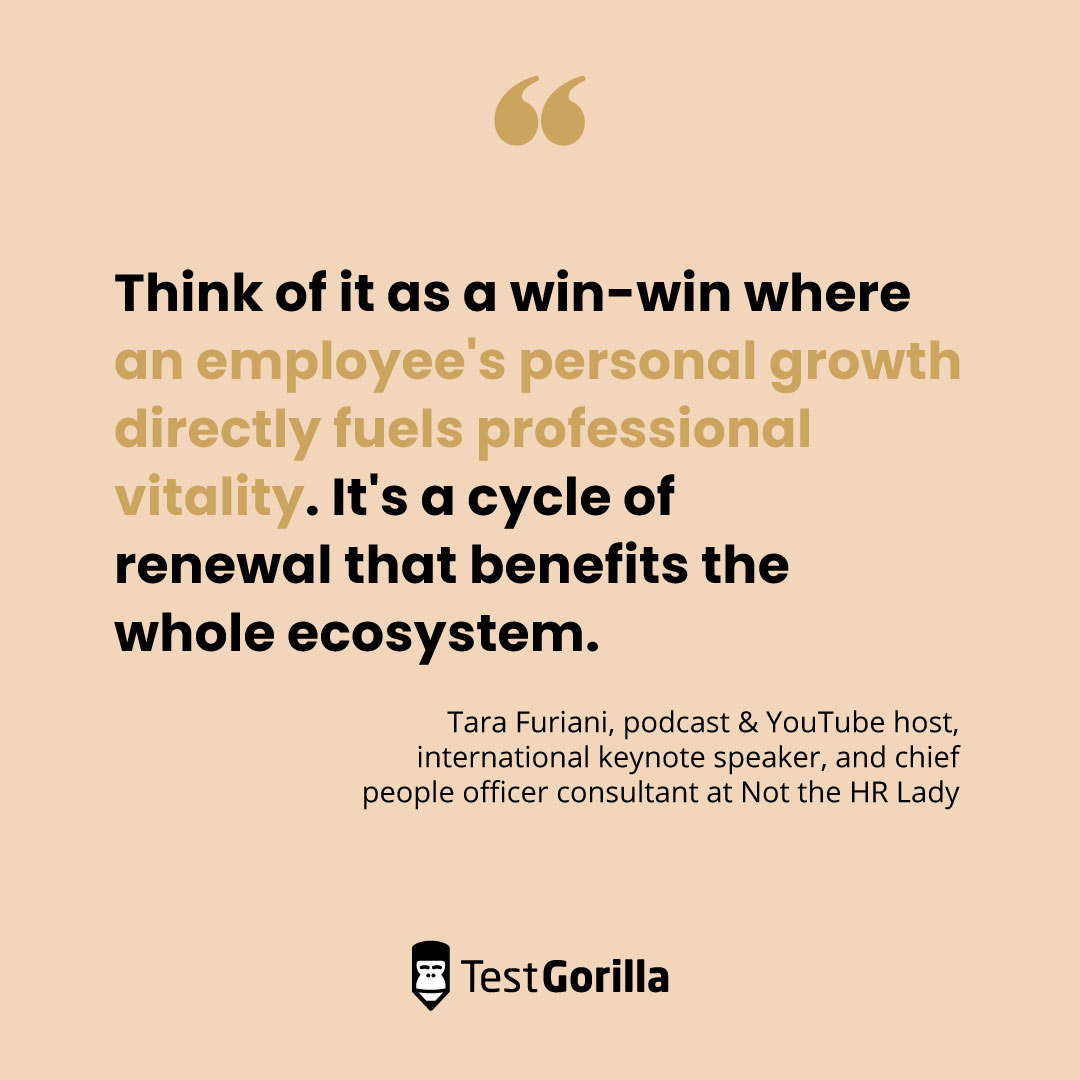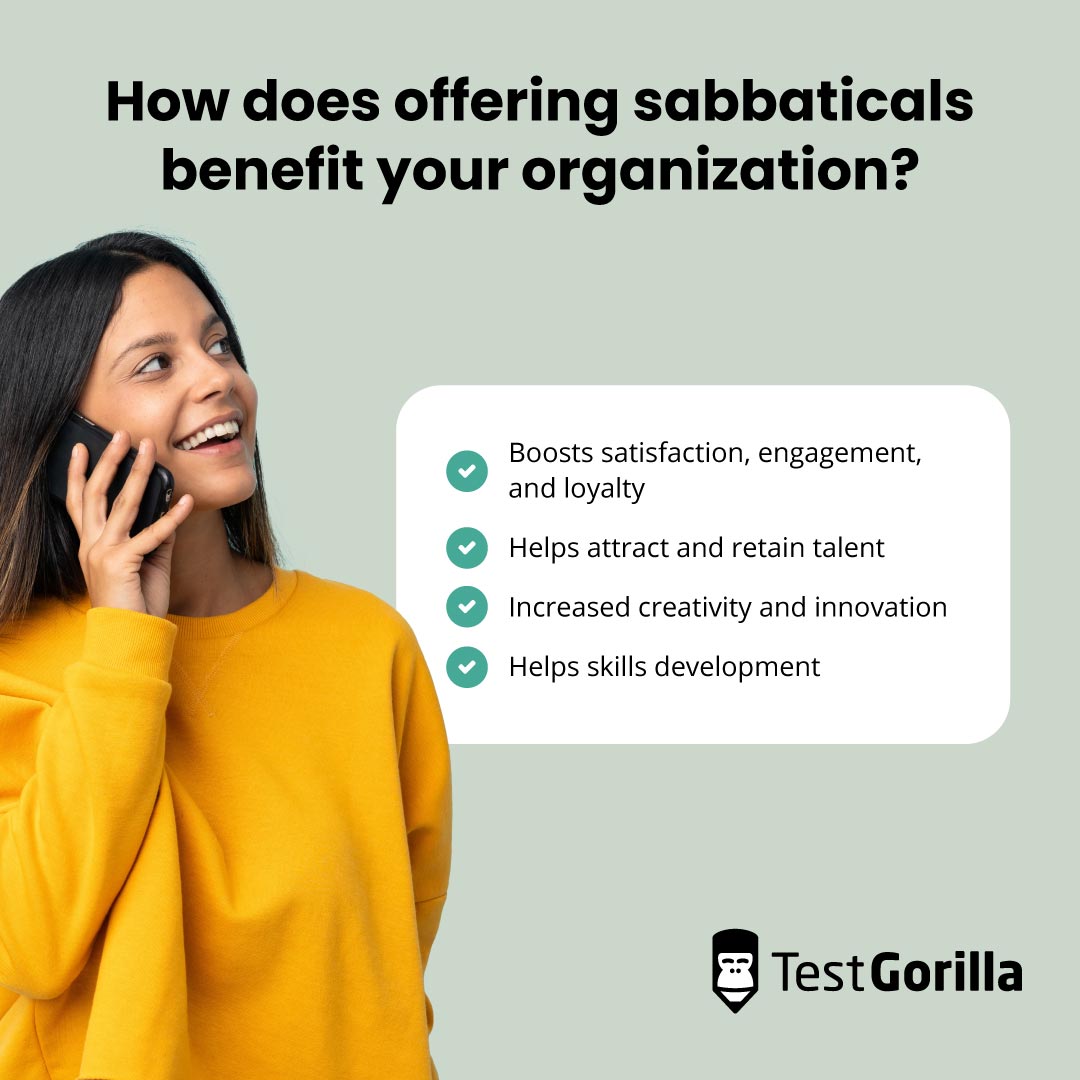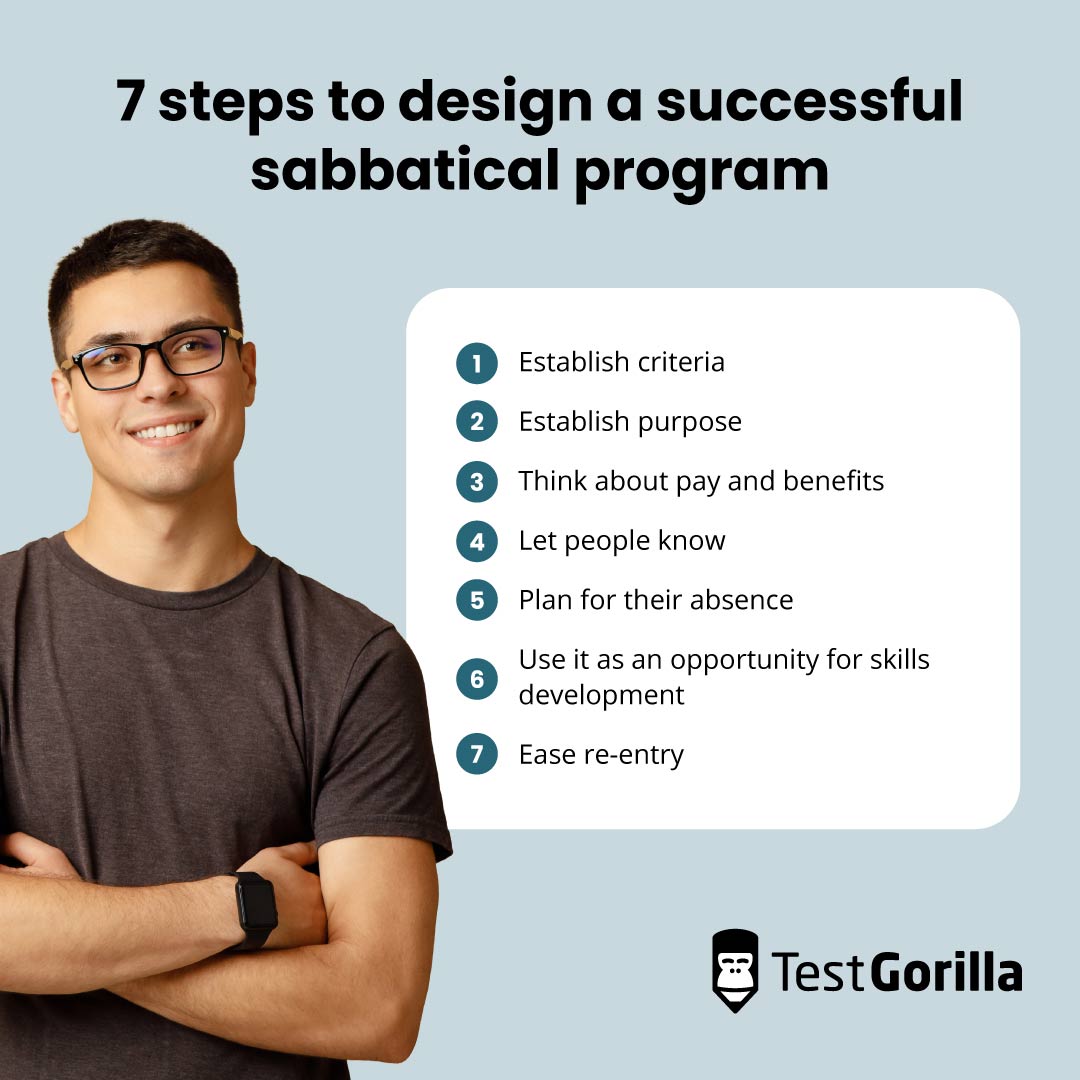Amal is a skilled client account manager at a digital marketing agency. He loves his work but, after 10 years, he’s starting to feel burnt out by client demands.
Fortunately, he was able to negotiate a sabbatical with his company rather than leaving. As well as getting a much-needed break, he used the time to take courses in project management and search engine optimization. This meant he came back with new skills and a renewed appreciation for his work and that of other departments.
Offering sabbaticals can make you more attractive to top talent. However, you need to design your sabbatical program carefully to avoid negatively impacting your teams and company.
In this post, we’ll explore the benefits of sabbaticals and how to design a successful program that mitigates their risks. We’ll also look at how to use them as an opportunity for skills development that provides maximum value to your employees and your organization.
Table of contents
How does offering sabbaticals benefit your organization?
“For employees, the sabbatical is like a pressure release valve,” says Tara Furiani, podcast & YouTube host, international keynote speaker, and chief people officer consultant at Not the HR Lady.
“They get a hiatus to pursue personal or professional interests, be it travel, writing, learning a new skill, or volunteering. The newfound knowledge and perspectives they bring back are invaluable and companies gain in the form of a revitalized, more engaged workforce. Think of it as a win-win where an employee's personal growth directly fuels professional vitality. It's a cycle of renewal that benefits the whole ecosystem.”
Good to know: Sabbaticals differ from other types of break in the following ways: Purpose: Sabbaticals are intended for personal or professional growth or pursuing your passion. They can be used to focus on physical and mental health, study, or volunteering. Vacations are typically used for relaxation, leisure, and enjoyment, and to provide a brief respite from daily routines and stressors. Duration: Sabbaticals are extended periods of leave from work, often lasting between a month to a couple of years. So, typically longer than a vacation. |
Now you know what a sabbatical is, let’s take a look at the benefits in more detail.
Boosts satisfaction, engagement, and loyalty
In an age of blurry work-life boundaries, rapid turnover, and diminishing loyalties – on both sides – sabbaticals allow employees to recharge and grow.
This, says Kraig Kleeman, chief executive officer and founder of The New Workforce and Kraig Kleeman Live, means they “often return to work with loyalty and gratitude, which can translate into higher engagement and productivity.”
This shows that even paid sabbaticals can benefit you in terms of retention and, therefore, ROI on hiring.
Helps attract and retain talent
Attracting and retaining top talent these days takes more than a paycheck. Not all companies offer sabbaticals, so doing so gives you an advantage.
“Sabbaticals are more than a HR perk; they're a talent magnet and retention powerhouse,” says Tara, “The new crop of talent thrives on the promise of meaningful experiences that extend beyond the cubicle. They want the latitude to explore, rejuvenate, and even contribute to causes they’re passionate about.”
Sabbaticals are also a chance to destress and improve mental and/or physical wellbeing. This helps avoid the burnout that can lead to quiet quitting and employee churn.
All of the above is particularly important to Gen Z, so offering sabbaticals demonstrates a commitment to their wellbeing and personal and professional growth. This can help prevent them seeking new opportunities elsewhere.
Increased creativity and innovation
Time away from the daily grind can lead to increased creativity, fresh ideas and perspectives, and innovation on an employee’s return. Their renewed outlook, experiences, and skills can contribute to new ways of thinking and working that positively benefit both of you.
“It's like hitting the refresh button on your workforce, leading to new ideas and better problem-solving,” says Kraig.
Case study: Patagonia Outdoor gear retailer Patagonia has a strong commitment to the environment. Recognizing that its employees share its passion for protecting nature, the company offers two months paid leave to participate in its Environmental Internship Program. As well as giving employees a break and the chance to grow, the program provides valuable support to local grassroots organizations. When employees return, it's often with fresh inspiration and commitment to the company’s mission. |
Helps skills development
Sabbaticals are a great opportunity to develop skills – and not only for those taking time out.
Employees can acquire new skills or experiences that benefit your organization, like learning about innovative practices. They might also conduct research and publish an article or book that contributes to their field. Or they might travel and gain new cultural experiences or volunteer activities that strengthen their skill sets and viewpoints.
“Sabbaticals can also create a pathway to support career development and internal talent mobility by allowing others in the company a chance to step into roles on an interim basis,” says Dana Nagengast, senior executive advisor at McLean & Company.
With this in mind, sabbaticals are a good opportunity to train new leaders, road test succession planning, and ease transitions caused by retirement or internal promotion.
What are the risks of offering sabbaticals?
While sabbaticals offer numerous benefits, there are potential risks to consider:
Loss of knowledge and skills. When someone takes a break, the temporary knowledge and skills gap might affect overall productivity, which can impact teamwork or customer service.
Financial risk. Paid sabbaticals, or even just maintaining benefits during the absence, put a strain on your budget.
Impact on remaining employees. Sabbaticals need to be carefully managed to avoid overloading remaining employees and causing disruptions, which can lead to resentment.
You could lose people. Some people may not want to return afterward, so you lose a valuable employee. However, this can be a good thing as you “weed" out those who aren’t invested in being part of your organization.
Now you know the benefits and challenges, let’s take a look at how to set up a successful sabbatical program.
7 steps to design a successful sabbatical program
“Crafting a sabbatical program isn't something you slap together on a Friday afternoon,” says Tara, “It demands a calibrated approach.”
Here are some key steps to ensure your program aligns with company goals and employee needs while minimizing risks.
1. Establish criteria
One employee taking a few weeks or months off every few years may not be a significant expense, but it adds up when applied to your entire workforce. To mitigate this – and make planning for their absence easier – you should set criteria for maximum duration, frequency, and eligibility.
Many organizations determine eligibility based on factors like tenure and performance: You’re entitled to X weeks/months after X years of service. However, for industries like tech where tenures tend to be short, offering short but frequent breaks may be enough.
Other things to consider:
Accruable leave. If someone becomes eligible after five years but doesn’t take a sabbatical, do they lose that time or does it accumulate? What’s the window for them to use it or lose it?
Consecutive use of time. Can they use a couple of weeks here and there, or all in one go? Can leave be extended, and under which circumstances?
Continued tenure. Does the time away count toward overall tenure? This will be important when determining eligibility for promotions and pay raises.
Contractual obligations. To avoid brain drain, some companies mandate a certain tenure post-sabbatical. Others stipulate you can’t go work for a competitor.
Approval criteria. What should managers consider when approving or denying requests? Could “losing” that employee jeopardize a project or client relationship? What if their proposed dates clash with another employee’s leave?
2. Establish purpose
Sabbaticals aren’t a vacation: You’re giving employees time to go and do something that benefits both of you. This means you need to define clear objectives and goals. For example, is it for personal growth, research, or other reasons? Think about any job-related outcomes you expect and how to align them with team and company goals.
Use analytics, surveys, and employee feedback to construct a program that meets both organizational objectives and individual aspirations. For example, under a learning and development program, you could give a content writer leave to write a book. This benefits you both by developing their writing and, presumably, time management skills.
3. Think about pay and benefits
Continuing to pay salary, benefits, and perks during sabbaticals is a drain on company finances but it pays off in reduced financial stress for the employee. This is particularly important if they’re taking a break to improve wellbeing or grow a risky side hustle. You might also cover the cost of any training undertaken, especially if it’s of benefit to you.
“One common design in terms of benefits may include some percent reduction in compensation or health benefits coverage,” says Dana, cautioning: “This can have a longer-term financial risk on an individual’s retirement savings.”
4. Let people know
Rolling out a sabbatical program and having it collect dust won't do. Once you’ve set up your program, you need to shout about it.
Use active, open channels, two-way communication channels, like Q&A sessions, testimonials, or an FAQ section on your internal portal. Whatever it takes to make sure the benefits are loud and clear. “A transparent culture,” says Tara, “will make the sabbatical program part of your organization's DNA, rather than a dormant policy no one dares touch.”
To inspire others, share stories of employees who have successfully leveraged their sabbatical-acquired skills within the organization. This can also help mitigate resentment from those left behind, as can establishing anonymous employee feedback channels for people to share concerns.
“It’s important to clearly communicate a sabbatical program with as many details as possible, fostering transparency and trust,” says Dana, “establish a company policy and procedure that addresses the purpose and goals, eligibility, and salary/benefit considerations. There should also be some training or education provided to the employee, so they can understand all the implications upfront and confirm if the value aligns for them personally and professionally.”
5. Plan for their absence
Losing any employee for any length of time is a risk, so a plan to redistribute their workload will help avoid workflow wobbles. Forward planning is also crucial to avoid overloading those left behind and causing burnout or resentment.
Work with the employee and their manager to decide whether you should divide their responsibilities among the team or hire someone to fill in. You should also prepare those taking on additional responsibilities during a colleague’s sabbatical and use talent assessments to evaluate skills gaps.
“Leverage cross-training across departments,” says Tara, “This doesn't just mitigate the risk of skill gaps during sabbaticals, but cultivates a more versatile workforce long-term.”
Make sure the knowledge handoff is smooth. For example, if an employee is client-facing, allow time to train their replacement in the specifics of the account and introduce them to the client. You should also have a contingency plan to mitigate risks like workflow disruptions or employees who don’t return.
6. Use it as an opportunity for skills development
Sabbaticals are a great chance to develop new or existing skills through formal training or pursuing personal interests that align with career aspirations. Employees may also practice and deepen their industry expertise or explore new fields to acquire new skills.
Dana recommends strategically timing sabbaticals to align with new skill development, like upskilling to adopt new technologies. For example, your content writer might learn prompt engineering to make the most of generative AI tools.
“Sabbaticals can be breeding grounds for accelerated growth,” says Tara, “in prior roles, we've partnered with online learning platforms, giving our employees the resources they need to develop new skills during their time off.”
To make the most of this opportunity:
Work with employees to create a detailed learning plan pre-sabbatical. Think about how the courses, etc. they take will benefit both of you. Use talent assessments to evaluate skills gaps, so you know what to focus on.
Encourage them to share updates during their sabbatical. For example, milestones, insights gained, or new skills acquired.
Evaluate skills on their return. For this, you can use talent assessments, interviews, or practical demonstrations. Perform skill mapping to determine which departments or projects can benefit from new skills and how you’ll transfer them. For example, through peer-to-peer learning, mentoring, or contributions to cross-functional projects.
7. Ease re-entry
“A sabbatical is a journey,” says Tara, “and like all journeys, the return can be jarring.”
This means you need to help employees transition back into their role. For example, a structured "re-entry" period with catch-up sessions, company updates, and training on new tools or platforms adopted in their absence. Digital skills in particular can become outdated in a matter of months. All this helps them readjust to the current work environment.
Once they're settled, a focused performance review can help unpack the treasures from their voyage. What new skills did they acquire? How has their perspective broadened? The answers may inform future project assignments, potential promotions, or even shifts in team dynamics like increased peer to peer recognition. Now’s the time to make those new skills count.
Sabbaticals: One way to attract and retain top talent
Sabbaticals can be a powerful tool to attract and retain top talent, boosting employee satisfaction and engagement and fostering skills development. However, you need to plan them carefully to make the most of the opportunity – for your employees and your organization.
To do this, establish criteria, tie sabbaticals into individual and company goals, and communicate the benefits. You also need a plan for how to manage in someone’s absence and how to help them transition back into work afterward.
Use talent assessments to maximize the opportunities for skills development, including refreshing skills on their return or upskilling those taking over. When you do all this, you’ll have a sabbatical program that helps your organization and your talent thrive.
Want more ways to retain top talent? Skills-based hiring improves retention by up to 89%. Download the 2023 State of Skills-Based Hiring report to learn more |
Related posts
Hire the best candidates with TestGorilla
Create pre-employment assessments in minutes to screen candidates, save time, and hire the best talent.
Latest posts
The best advice in pre-employment testing, in your inbox.
No spam. Unsubscribe at any time.

Hire the best. No bias. No stress.
Our screening tests identify the best candidates and make your hiring decisions faster, easier, and bias-free.
Free resources
This checklist covers key features you should look for when choosing a skills testing platform
This resource will help you develop an onboarding checklist for new hires.
How to assess your candidates' attention to detail.
Learn how to get human resources certified through HRCI or SHRM.
Learn how you can improve the level of talent at your company.
Learn how CapitalT reduced hiring bias with online skills assessments.
Learn how to make the resume process more efficient and more effective.
Improve your hiring strategy with these 7 critical recruitment metrics.
Learn how Sukhi decreased time spent reviewing resumes by 83%!
Hire more efficiently with these hacks that 99% of recruiters aren't using.
Make a business case for diversity and inclusion initiatives with this data.






















